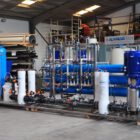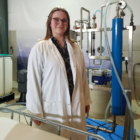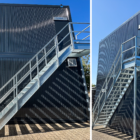The submersible motor pump is an essential component in industrial water and waste water technology. It belongs to the group of centrifugal pumps and is characterized by the fact that it is completely immersed in the medium to be pumped during operation. This enables reliable and efficient pumping of water, waste water, sludge or chemically contaminated media.
In the industrial water treatment the submersible motor pump has a wide range of applications - for example in waste water pumping, sludge treatment, in cooling water circuits and in process water systems. Thanks to its compact design and high performance, it can also be used reliably under demanding operating conditions, such as high pressures or aggressive media.
Table of contents
Technical structure of a submersible motor pump
The submersible motor pump consists of several central components that together ensure safe and efficient operation:
Pump housing:
- Made of materials such as cast iron, stainless steel or special corrosion-resistant plastics, depending on the medium and chemical load.
Impeller:
- The impeller is the heart of the pump. It ensures the conversion of the mechanical energy in Hydraulic energywhich conveys the medium. Different impeller types are used depending on the application:
- Free-flow impellers: For heavily contaminated wastewater and media with solids.
- Semi-open or closed impellers: For clear water or lightly contaminated media.
- The impeller is the heart of the pump. It ensures the conversion of the mechanical energy in Hydraulic energywhich conveys the medium. Different impeller types are used depending on the application:
Sealing system:
- A submersible pump must be reliably sealed to prevent water from entering the motor. This is achieved by:
- Shaft seals and mechanical seals that ensure a secure seal.
- An oil pad as an additional protective barrier.
- A submersible pump must be reliably sealed to prevent water from entering the motor. This is achieved by:
Submersible motor:
- The electric motor is hermetically sealed and designed for use under water. The motors are often equipped with thermal and humidity sensors to detect overheating or leaks at an early stage.
- Three-phase motors are common because they offer high performance and are robust against demanding operating conditions.
Cable gland and protection systems:
- Specially insulated cables ensure that the power supply is safe even under water.
How a submersible motor pump works
The function of a submersible pump is based on the centrifugal pump principle:
Energy conversion:
- The electric motor drives the impeller, which accelerates the liquid through rotation.
Hydraulic conveying:
- The centrifugal force transports the medium from the pump inlet to the pump outlet and raises it to a higher energy level.
Operation under water:
- As the pump is completely immersed in the medium to be pumped, it is cooled at the same time. This prevents overheating and reduces mechanical wear.
Pressure build-up:
- The liquid leaves the pump at the speed and pressure generated by the impeller.
Advantages of submersible pumps
The submersible motor pump offers numerous advantages that make it an indispensable component in water technology:
- Compact design: Space-saving installation directly in the pumped liquid.
- High operational safety: The pump works completely under water and is protected against dry running by a level switch.
- Efficient cooling: The motor is cooled by the surrounding medium, which prevents overheating.
- Versatility: Can be used for clean, contaminated and aggressive media.
- Robustness: Resistant to abrasive solids and corrosive media.
Maintenance and operation of submersible pumps
Safe and efficient operation of the submersible pump requires regular maintenance:
Leak test:
- Check the shaft seals and mechanical seals to detect leaks at an early stage.
Inspection of the impeller:
- Check for wear, especially with media containing abrasive components such as sand or sludge.
Cable testing:
- Ensuring insulation and electrical connections.
Checking the sensors:
- Humidity and thermal sensors must be calibrated and tested regularly.
Cleaning the pump:
- Deposits and blockages should be removed regularly to ensure the pumping capacity.
Conclusion
The submersible motor pump is an indispensable unit in industrial water and waste water technology. Thanks to its compact design, high performance and versatility, it enables the reliable pumping of water, waste water and sludge under demanding conditions.
Thanks to modern technologies such as robust sealing systems, thermal monitoring and fail-safe sensors, submersible motor pumps offer maximum operational reliability with low maintenance requirements. Particularly in areas such as waste water treatment, sludge pumping and cooling water systems, they make a significant contribution to the efficiency and reliability of water technology.
For further information on our products, please feel free to contact us at any time!








